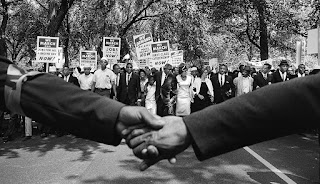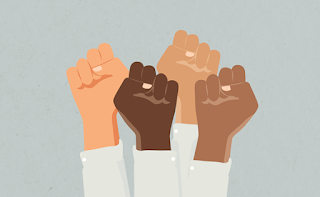Opposing Viewpoints
Delilah Calvo
Professor JoAnne Harris
English 1101- Section 30
1 April 2020
Racial Profiling
"Racial Profiling." Gale
Opposing Viewpoints Online Collection, Gale, 2020. Gale In Context: Opposing Viewpoints,
https://link.gale.com/apps/doc/PC3010999266/OVIC?u=ggcl&sid=OVIC&xid=199eedaa.
Accessed 1 Apr. 2020.
Racial profiling
is a societal issue that we have been dealing with for many years and even now
it still is present. Racial profiling is when you suspect someone of committing
a crime based on their stereotypes tied to their race and in the United States
this is a huge issue. We see it in law enforcement, education, our jobs, when
you travel and just everyday life it unfortunately happens. It’s dated all the
way back to when we passed the Fugitive Slave Act in 1793, it set a course of
other acts to come into play about putting restrictions on a specific race. Racial
profiling was high in New York back in the mid-’90s when they had the power to “stop-and-frisk”
anyone they had a suspension of. If you look at the numbers, it shows that the
majority of the people being stopped were African American and Latinos and it
wasn’t until 2014 that they issued that law enforcement could not stop anyone
unless they had a weapon that served as a threat to the officers and after that,
the numbers dropped dramatically. Senators today are reintroducing old acts to
push the effort of stopping racial profiling, but Trump and his administration
don’t see it as a serious issue. Instead, Trump placed a travel ban on countries
that are majority Muslim because of the stereotype of all Muslims being terrorists
and that is just wrong. Racial profiling is unfortunately never going to stop,
but there are ways to limit it and we as a society are working towards accepting
all races, ethnicities, nationalities, and religions.
Behavioral Disorders
"Behavioral Disorders." Gale Opposing Viewpoints Online
Collection, Gale, 2019. Gale In Context: Opposing Viewpoints,
https://link.gale.com/apps/doc/PC3010999115/OVIC?u=ggcl&sid=OVIC&xid=08cbca8e.
Accessed 1 Apr. 2020.
Behavioral disorders are more common
than we like to think, but it’s much more than a rebellious teen, or a disobedient
child. Disorders like Oppositional defiant disorder (ODD) and conduct disorder
(CD) are the primary behavioral disorders found in adolescents and researchers
say that it’s not the child’s fault that they act this way, but their upbringing
that made this way. Everything that a child experiences in the early ages of life
tends to affect who they become and how they act. Adolescents who are diagnosed
with behavioral disorders typically have a risk factor linked to their behavior
and it’s either biological, psychological, or social. Biological meaning that there
is some family history of said disorders or they're exposed to unhealthy habits
that are consistent in their everyday lives. Psychological factors are when parents
are absent in their lives, or when they develop an unhealthy relationship early
with their children. Social factors are linked to their environments, and children
notice when they are living in a high poverty area or when their parents don’t
discipline them correctly. All these can lead to adolescents hurting themselves
or others. CD is more an aggressive behavioral disorder, where they act out
more towards authority figures or blatantly don’t care who they hurt in their
way. A lot of stigmas come into this, like with any disorder, and it makes it
hard sometimes for anyone to seek help. When parents are presented with the
possibility that their child might need serious help, they fear the judgment,
the possible chance of being questioned by authorities and so it can lead to a
long road of problems for the child. Behavioral disorders should be taken more
seriously and when they are you see positive results, real changes and changed
people.
Child Pornography
"Child Pornography." Gale Opposing Viewpoints Online
Collection, Gale, 2018. Gale In Context: Opposing Viewpoints,
https://link.gale.com/apps/doc/PC3010999246/OVIC?u=ggcl&sid=OVIC&xid=bfe227c6.
Accessed 1 Apr. 2020.
As
disgusting as it is, child pornography exists, and it has gotten worse over the
years. Child pornography is any sexual content involving minors under the legal
age of eighteen and now is known as child sexual abuse material (CSAM). Any
distribution, production, or possession of child pornography is considered a
federal crime and it’s also a crime to try to persuade any minors in performing
in any sexual acts or favors. Most of the children found in these videos are
children that have been missing and organizations such as, the National Center
for Missing Exploited Children (NCMEC), receive images of children and the numbers
are in the millions. Organizations like NCMEC are working every day to depict
images and find names for these children, trying to find where they are at. The
predators don’t stop there. These predators coerce these young kids to start
webcam feeds recording themselves doing explicit acts or having them send
private photos to them. They use cryptocurrencies to pay these kids and stay
under the radar and law enforcement use financial records to find who they are
targeting. In 2006 the Sex Offender Registration and Notification Act allows the
public to view all sex offenders in their area, and that was to help any concerned
citizens' minds. Law enforcement takes sexual offenders seriously and uses their best
efforts to find these children and help them out this horrible situation.



Comments
Post a Comment